
Editor’s note: In 1944, the US War Department published FM 21-22, a manual on military watermanship. The manual covers everything a man needs to know to survive at sea, from how to properly abandon a sinking ship to how to stay alive in a lifeboat. This week we’ll be highlighting several of the manual’s sections; the information is both fascinating from a historical standpoint and useful for worst case scenarios.
FM 21-22 War Department Watermanship Manual, 1944
Protection Against Water Animals
GENERAL.
Some water animals attack man only in self-defense; others may attack if attracted by blood, shiny objects, and light colors such as that of a man’s skin. Don’t drag your hands or feet overboard. The best defense against water animals is to look for them and detour around them. Observe underwater, on the bottom of shoals, among rocks, and at the surface. Swim slowly and quietly. Keep your clothing on if dangerous fish are known to infest the water. Move away from any blood in the water. It is important to remain calm, especially when stung by water animals; their stings will wear away.
SHARK.

White shark — “man-eater.”
a. Sharks are distributed widely but are most common in warm seas. They have long, round, slender bodies with the upper lobe of the tail fin longest, and with five distinct openings to the gills along the side of the head. The most dangerous sharks have unsymmetrical tails. The body normally measures not more than 11 feet. The mouth is large and armed with cutting teeth; the nose usually is conical, bluntly pointed, and protrudes well in front of the mouth. Sharks usually attack on the surface and are revealed by their fins, which break the water like a periscope.
b. Defense against a shark attack consists in splashing, moving the arms and legs rapidly, and making a great deal of commotion underwater. Metallic noises such as striking a canteen under water are best. Avoid display of skin, underclothing, or shiny objects. The snout is the most sensitive part of the shark’s body; by striking a blow on the snout you may drive him away. Treat in the ordinary manner any wounds received.
BARRACUDA.

The barracuda is found only in the warm seas. It is a long, grayish, pikelike fish with long, pointed jaws lined with sharp teeth. It is about 6 feet long and usually is attracted by anything that moves but especially by light-colored or shiny objects. It attacks quickly from below the surface. Creating noise underwater may frighten it away. Treat in the ordinary manner any wounds received.
STING RAY.
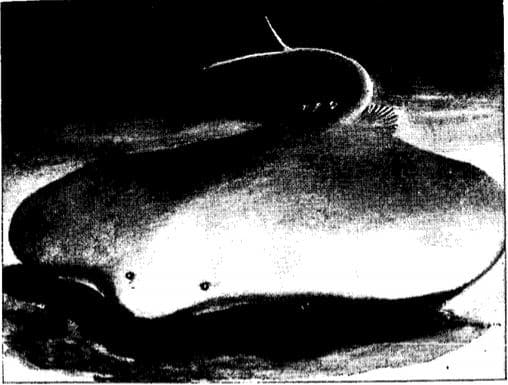
a. Sting rays, found in all warm seas and in some fresh water rivers, are disk-shaped, flattened fishes with one or two long, barbed spines. The disk is made up of both body and fins. Sizes range from that of an ordinary dinner plate up to 10 feet across. The tail may be as long or longer than the disk. Since they conceal themselves in muddy or sandy flats, they are frequently stepped upon and lash out with their tails, driving the spine into the flesh and injecting a highly venemous substance. Treat wounds like snake bites.
b. When walking in turbid or muddy water, poke ahead of you with a stick and slide your feet along. If stick or feet touch a hidden sting ray it will swim away.
SAW-FISH.
The saw-fish has a body similar to the shark’s and, in addition, a swordlike snout is armed with spines on the sides giving the impression of a large double-edged saw. The saw-fish may reach a length of from 10 to 20 feet but it is not vicious. It lives over sandy and muddy bottoms. The saw-fish can swing its saw back and forth with power enough to break a man’s leg. The most tender parts of the saw-fish are the areas around the eyes and at the base of the saw. Defense consists of striking area of eyes and avoiding the saw.
MORAY EEL.

The moray eels are found in all warm seas, especially in crevices about coral reefs. Most morays are brownish or blackish colored with peculiar patterns of varied spots. Some morays reach a length of 6 feet. A knife or spear may be used in defense against the moray. Keep your hands and bare feet out of rock crevices. Treat in the ordinary manner any wounds received.
SEA PORCUPINE.

Found in warm seas, the sea porcupine is recognized easily by its covering of erectile spines. This fish swells itself up by swallowing water or air. It is not ferocious. Its jaws are like the beak of a parrot and powerful enough to bite off a finger if they are molested. Defense consists of keeping out of their way.
SEA URCHIN.
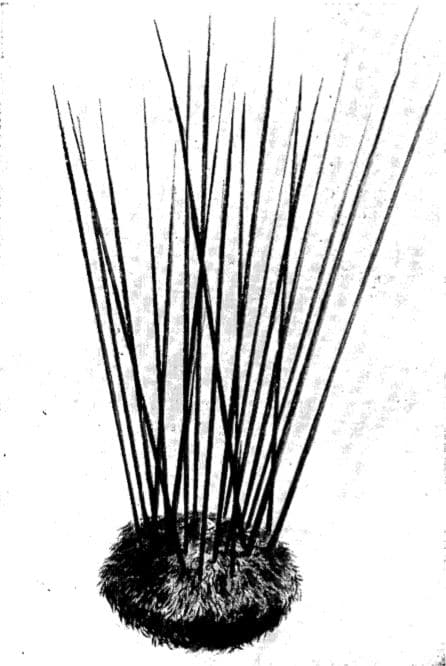
The sea urchin occurs abundantly on rocks, reefs, and among coral and looks like a pincushion full of long needles. Some sea urchins are covered with numerous movable spines of two different sizes. Sea urchins with short, stout spines are not poisonous. The shorter and finer spine is highly venomous; if it touches the skin gently the poison is injected into the flesh causing sharp, severe pain. Remove the spine and apply iodine. Be suspicious of anything that resembles a sea urchin; don’t handle it.
GIANT CLAM.
Found on tile coral reefs in the Pacific and Indian Ocean, giant clams are similar to the ordinary clam but of tremendous size, sometimes weighing more than 500 pounds. The clam is edible, but care must be taken that no part of the body is trapped within the shell, which clamps on to anything that enters it.
OCTOPUS.
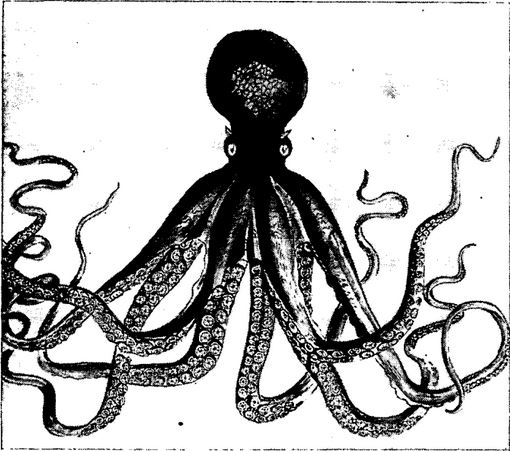
Commonly found in the Mediterranean and the Southwestern Pacific, the octopus has a round body and eight arms or legs on each of which are numerous suction cups. The octopus may grow to over 10 feet from tip to tip of the tentacles. It has large keen eyes which shine in the dark. When attacked it emits an inky fluid into the water to screen its actions while escaping. The octopus is not a vicious animal and when attacked will try to escape. They occur most frequently along rocky shores and on reefs. Some kinds live at considerable depths in the sea.
ELECTRIC RAY.
In shape the electric ray is similar to the sting ray except that its tail lacks the sting. On being touched, the animal imparts a severe electric shock from batteries located along its back. If shocked, remain calm and quiet and wait for the shock to wear off.
BLUEFISH.
Bluefish are unusually active game fish abundant in the Atlantic Ocean and English Channel. They are generally 2 to 3 feet long and blue in color. They have razor-sharp teeth and will attack any moving object. Schools of bluefish are dangerous to a swimmer. Treat inflicted wounds in the usual manner.
JELLYFISH.
Found in all seas but more numerous in the tropics, the jellyfish is an umbrella-shaped animal of jellylike substance, with numerous tentacles hanging down from the under side. Jellyfish vary from a few inches to 2 or 3 feet across. Contact with a tentacle causes severe stinging sensation. Application of slightly diluted ammonia water gives immediate relief. If stung while swimming remain calm and swim slowly until the effects wear off. The jellyfish cannot follow you. Clothes give full protection to all parts of body so covered.
PORTUGUESE MAN-OF-WAR.
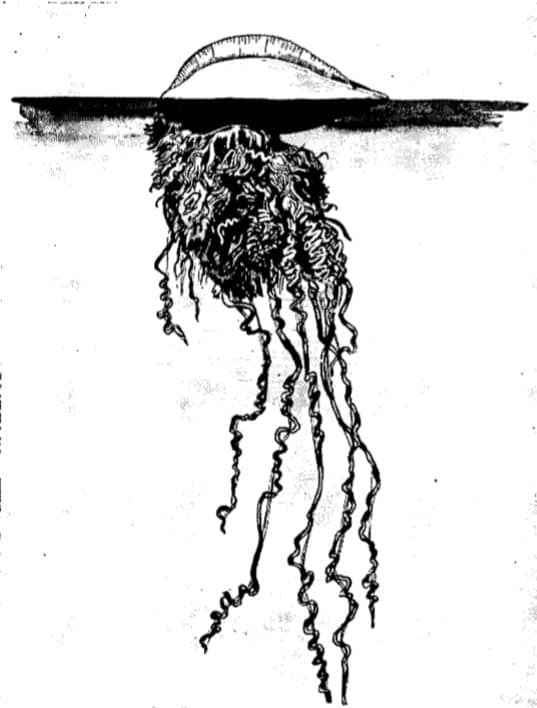
Commonly found in most war seas, the brightly colored Portuguese man-of-war has a large bladder-like body with long tentacles hanging down from the under side. It usually floats on the surface. It imparts a more severe sting than a jellyfish, but the sting is treated in the same manner. Watch for the floating bladder and keep away from it.
SEA SNAKE.
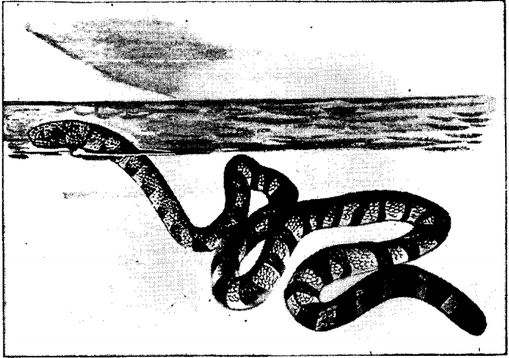
Sea snakes can be distinguished from eels because they are covered with bony plates or rectangular-shaped scales. They are found in the warm waters of the Indian and Pacific Oceans and, a fresh-water variety, in the Philippine Islands. The sea snake is usually banded with bright colors. The tail is flattened to form a paddle. Sea snakes rarely bite without provocation but stay away from them. Their venom is poisonous; treat wound immediately. First apply a tourniquet between the bite and the heart. Next with a knife make a criss-cross out of each fang prick and suck out the blood and poison by mouth and spit. Finally apply iodine. If your mouth contains any open wounds have someone else suck the poison.
CROCODILE AND ALLIGATOR.
Crocodiles and alligators are found in fresh water in Africa, Asia, Australia, and America. However, the largest and most dangerous crocodiles take to the open sea in the Indo-Australian region. Crocodiles and alligators are long, thick-skinned reptiles with a vicious, lashing tail and a long snout with big teeth. Stay away from them.







